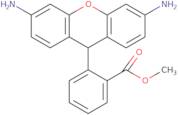Dihydrorhodamine 123
CAS: 109244-58-8
Ref. 3D-JEA24458
| 1mg | Discontinued | ||
| 5mg | Discontinued | ||
| 10mg | Discontinued | ||
| 25mg | Discontinued | ||
| 50mg | Discontinued |
Product Information
- Methyl 2-(3,6-diamino-9H-xanthen-9-yl)benzoate
- Benzoic acid, 2-(3,6-diamino-9H-xanthen-9-yl)-, methyl ester
Dihydrorhodamine 123 is a fluorescent probe that is used to detect mitochondrial function. It is used in the study of diseases such as Parkinson’s, Alzheimer’s, and Huntington’s disease. Dihydrorhodamine 123 has also been used to measure the level of DNA damage in cells. This probe can be applied to biological samples by either an analytical method or polymerase chain reaction (PCR). Dihydrorhodamine 123 has been shown to bind to dinucleotide phosphate and reactive oxygen species (ROS) with high affinity and sensitivity. The fluorescence of this probe is sensitive to changes in pH, which makes it useful for measuring pH levels in cells.





